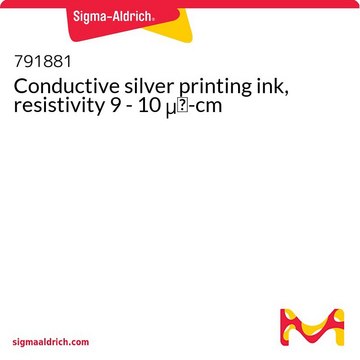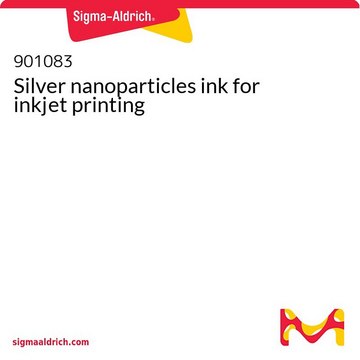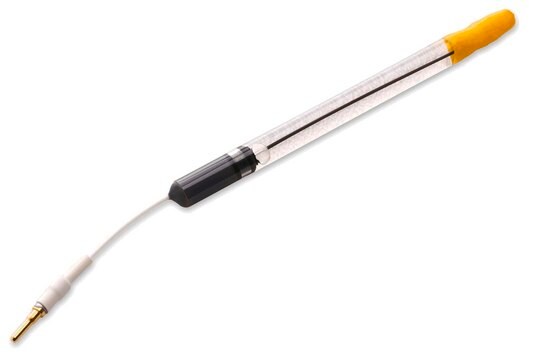901769
Flexible conductive silver paste for screen printing
Synonim(y):
Atrament Ag, Atrament przewodzący, C2080415P2, Srebrny atrament
About This Item
Polecane produkty
opis
Coverage: 250-270 cm2 per g (using a 230 mesh stainless steel screen)
Flash point: 90°C
Solid content: 44-46% (at 130°C)
Volume resistivity: 925 ohm cm at 60°C
527 ohm cm at 130°C
Formularz
paste
twardość
5B (pencil hardness)
lepkość
0.72-1.78 Pa.s (Haake RS1 C20/2° TiL at 230 sec-1 at 25°C)
Opis ogólny
Farba została poddana testom elektrycznym i mechanicznym, które wykazały, że jest bardzo elastyczna.
Zastosowanie
- Sitodrukowy materiał z pasty srebrowej do półprzezroczystych i elastycznych fotodetektorów metal-półprzewodnik-metal z procedurą fazy ciekłej: Niniejsze badanie przedstawia elastyczny fotodetektor MSM wykorzystujący przewodzące elektrody z pasty Ag wykonane w procesie sitodruku w fazie ciekłej, oferując wgląd w półprzezroczystość roztworów pasty Ag (Tsai et al., 2022).
- Wpływ spoiwa polimerowego na przezroczyste elektrody przewodzące na rozciągliwej folii wytwarzanej metodą sitodruku pasty srebrnej: Badania te analizują rolę spoiw polimerowych w pastach srebrnych stosowanych na elastycznych foliach poliuretanowych i poliestrowych, koncentrując się na właściwościach reologicznych (Lim et al., 2017).
- Osadzanie materiałów o wysokiej przewodności i niskiej zawartości srebra metodą sitodruku: Badanie nowych farb polimerowych obok tradycyjnych materiałów w postaci pasty pod kątem ich zastosowania zarówno w sztywnym, jak i elastycznym drukowaniu obwodów, z naciskiem na opłacalność i wydajność (Jewell et al., 2015).
- Drukowalność sitodrukowego czujnika odkształcenia z pastą sadza/srebro dla czułej elektroniki do noszenia: Bada zastosowanie nanokompozytów sadza/Ag w pastach do elastycznych drukowanych produktów elektronicznych, zwiększając czułość i elastyczność tych urządzeń (Qi et al., 2020).
- Proces syntezy nanocząstek miedzi o wysokim stężeniu do sitodruku pasty przewodzącej na elastycznym podłożu: Skupiając się na miedzi, badanie to dostarcza odpowiednich porównań z pastami srebrnymi, szczegółowo opisując formuły odpowiednie do sitodruku na elastycznych podłożach poliestrowych (Tam i Ng, 2015).
Cechy i korzyści
Pasta o niskiej zawartości srebra, charakteryzująca się niską rezystywnością, dobrą elastycznością i dobrą przyczepnością do wymienionych podłoży.
Właściwości fizyczne
Rezystywność arkusza: 15-20 mΩ/kwadrat przy 25 μm
30-45 mΩ/kwadrat przy 10 μm
Test zginania: atrament przetrwał 3 cykle
(Podłoże jest marszczone i zginane wewnętrznie i zewnętrznie za pomocą ciężarka o wadze 2 kg.
Próbka uległa uszkodzeniu, gdy opór osiągnął 10-krotność wartości początkowej.)
Podwójne utwardzanie: współczynnik starzenia -0,7% po podwójnym utwardzaniu w temperaturze 150°C przez 15 minut
Jak test wody: współczynnik starzenia -0,2% po gotowaniu przez 1 godzinę
Uwaga dotycząca przygotowania
Przed rozpoczęciem sitodruku należy dobrze wymieszać pastę bez wprowadzania pęcherzyków powietrza.
Sprzęt do sitodruku: półautomatyczny, ręczny
Żywotność sita: >3 godziny
Rodzaje sit: odpowiednie do stosowania z siatkami poliestrowymi lub ze stali nierdzewnej w zakresie od 156 do 325 tpi.
Typowe warunki suszenia: Suszenie w temperaturze 130°C - 150°C przez 10-30 minut lub na suszarce taśmowej z przepływem powietrza o temperaturze 130°C-170°C przez 5-10 minut.
Rozpuszczalnik do czyszczenia: etoksypropanol lub sericol
Podłoże: poliimid, PET, PEN, może być również drukowany na sztywniejszych podłożach, takich jak tlenek glinu.
Informacje prawne
Hasło ostrzegawcze
Warning
Zwroty wskazujące rodzaj zagrożenia
Zwroty wskazujące środki ostrożności
Klasyfikacja zagrożeń
Aquatic Acute 1 - Aquatic Chronic 1
Kod klasy składowania
10 - Combustible liquids
Klasa zagrożenia wodnego (WGK)
WGK 3
Temperatura zapłonu (°F)
194.0 °F
Temperatura zapłonu (°C)
90 °C
Wybierz jedną z najnowszych wersji:
Masz już ten produkt?
Dokumenty związane z niedawno zakupionymi produktami zostały zamieszczone w Bibliotece dokumentów.
Klienci oglądali również te produkty
Produkty
Professor Tokito and Professor Takeda share their new materials, device architecture design principles, and performance optimization protocols for printed and solution-processed, low-cost, highly flexible, organic electronic devices.
Nasz zespół naukowców ma doświadczenie we wszystkich obszarach badań, w tym w naukach przyrodniczych, materiałoznawstwie, syntezie chemicznej, chromatografii, analityce i wielu innych dziedzinach.
Skontaktuj się z zespołem ds. pomocy technicznej







![[6,6]-Phenyl C61 butyric acid methyl ester ≥99%](/deepweb/assets/sigmaaldrich/product/structures/359/221/d990c746-0960-4c69-bf76-fe09b193824d/640/d990c746-0960-4c69-bf76-fe09b193824d.png)



